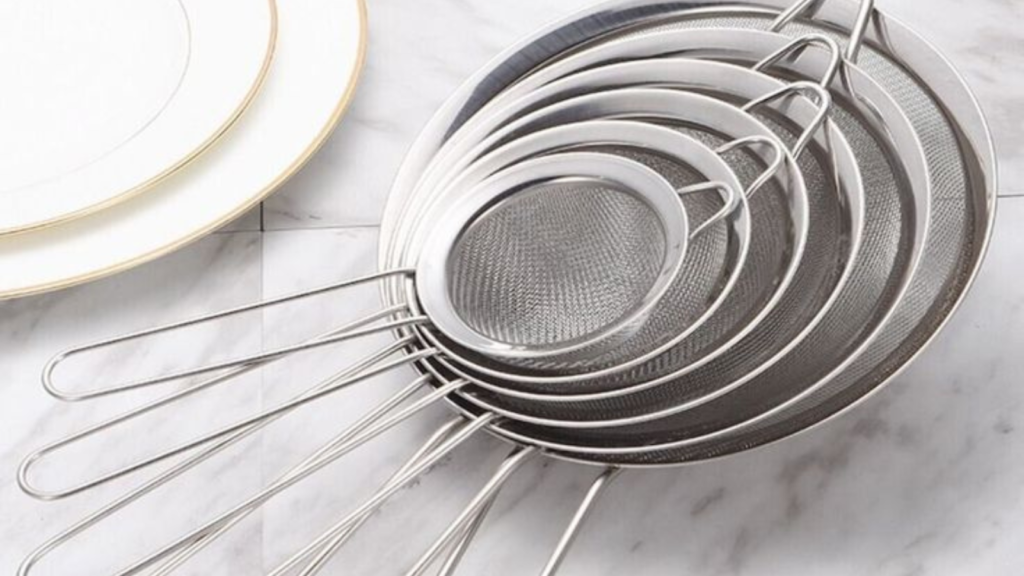Kitchen strainers come in handy for numerous tasks, like sifting tea and flour, rinsing vegetables, and draining pasta. While straining clear tea is easy, milk tea often leaves behind some residue that gets stuck in the mesh and contaminates subsequent food preparations.

Source: Pinterest
Though cleaning thin mesh might be a tough challenge however, you can secure your kitchen’s operations with the right skills and knowledge. We’ll be sharing, in great detail, useful cleaning hacks for your strainers.
Understanding the Importance of Cleaning a Strainer
Before diving into the cleaning hacks, it’s important to understand the need for maintaining a clean strainer. Food fragments caught in the mesh can lead to bacterial growth, and a blocked strainer is less functional since it cannot properly drain.

Source: Pinterest
Cleaning your strainer on a regular basis keeps it from rusting and wearing out. So here are a few quick hacks to help you maintain the cleanliness and optimal performance of your strainer.
Immediate Rinsing
You can make it easier to remove food particles and prevent them from drying and solidifying on the mesh by cleaning your strainer right after you use it. Immediately after use, give it a quick rinse under running water.

Source: Pinterest
Then use your fingers to free any particles that are stuck. If a sprayer is available, use it to completely clean all areas for finer meshes. This brief rinse helps keep food leftovers from setting in and becoming difficult to remove afterwards.
Soaking Method
Soaking can help loosen food particles in strainers and facilitate their removal from sticky residues. Simply add a few drops of dish soap to warm water in a big bowl or sink. Sbubmerge the strainer in the soapy water for fifteen to thirty minutes.

Source: Pinterest
This will cause any food that has become stuck to soften and be released. Then go ahead and scrub the mesh and frame with a brush or sponge after soaking. Rinse thoroughly with warm water and shake off the excess moisture to avoid rusting.
Toothbrush Method
A toothbrush can get through the thin mesh and loosen any stuck particles. Just apply a small amount of dish soap to the toothbrush. Then scrub the mesh gently in a circular motion, paying special attention to any areas where food is trapped.

Source: Pinterest
Rinse well with warm water to get rid of any soap residue and loose particles. This hack works very well for getting rid of sticky residue from rice or pasta, such as starch.
Baking Soda and Vinegar
While vinegar’s acidity can dissolve tough residues and leave the strainer smelling fresh, baking soda’s moderate abrasiveness aids in washing away food particles. Just cover the strainer with a sufficient amount of baking soda.

Source: Pinterest
To create a fizzy reaction, pour the vinegar over the baking soda, then let it sit. After a few minutes, scrub it with a brush or sponge. Then rinse thoroughly with warm water. When it comes to removing oily and difficult stains, this combo is magic.
BoIling Water
Boiling water can help dissolve and remove stubborn food fragments lodged in the mesh. Simply place a strainer over a sink and carefully pour boiling water over it while holding it over the sink.

Source: Pinterest
This hack works very well with metal strainers. Make sure to use tongs to prevent burns. The high temperature of the boiling water will help dissolve any remaining grease or food particles on the strainer.
Dishwasher Method
A dishwasher’s high temperature and strong water pressure can efficiently clean a strainer. Make sure the strainer is firmly in place in the dishwasher so that it doesn’t slide during the cycle. Also, use the regular wash cycle.

Source: Pinterest
Dishwasher-safe plastic strainers and metal strainers work well with this hack. Before putting the strainer in the dishwasher, it is recommended to give it a quick rinse first to get rid of any large food particles.
Lemon Juice and Salt Method
Lemon juice and salt work especially well for strainers that need a little extra care. Simply cut a lemon in half, then dip the cut side in salt to prepare the mixture. Scrub the strainer’s mesh and frame with half of a lemon.

Source: Pinterest
While the lemon juice offers a natural antibacterial benefit, the salt works as an abrasive to help remove food particles that have become lodged. Thoroughly rinse the sieve with warm water after.
Deep Cleaning for Persistent Stains
A deep cleaning technique could be required for strainers that have stains or smells that won’t go away. To make a thick paste, combine a tiny amount of hydrogen peroxide with baking soda.

Source: Pinterest
After applying the paste to the strainer’s soiled parts, leave it there for ten to fifteen minutes. Then scrub the paste into the spots with a gentle brush or sponge. Afterward, you can rinse properly with warm water
Preventative Maintenance Tips
Rinse your strainer immediately after use to keep food from drying and sticking, to ensure that it lasts longer and requires less thorough cleaning. Try to incorporate one of the above cleaning hacks into your kitchen cleaning routine.

Source: Pinterest
Additionally, make sure you regularly inspect your strainer for wear and tear, like rust or mesh rips. To make sure the strainer stays functional and safe to use. Make sure to replace it if needed.
The End
Although it might appear insignificant, cleaning a strainer is essential to preserving kitchen hygienic practices and the tool’s functionality. You can make sure your strainer stays in top shape by using the tips we’ve provided.

Source: Pinterest
Maintaining clean kitchen instruments not only enhances their functionality but also helps create a healthier cooking atmosphere. So, keep these tips in mind the next time you use your strainer to maintain a spotless and ready environment.
